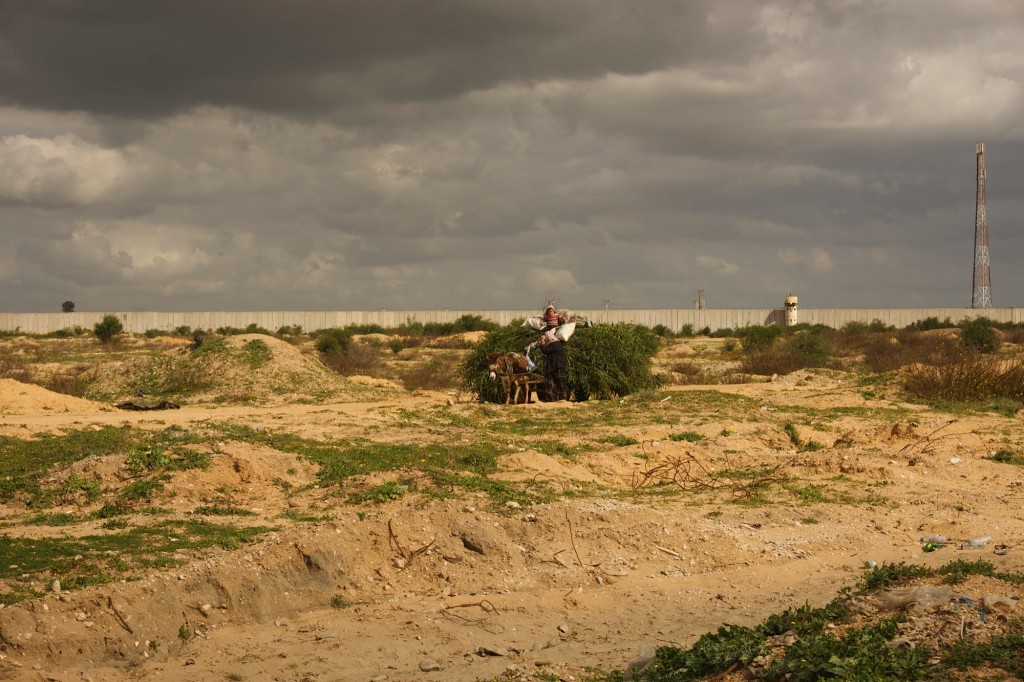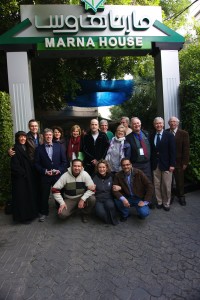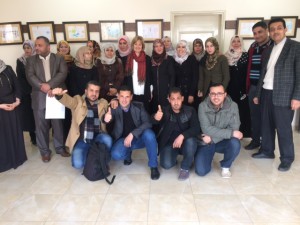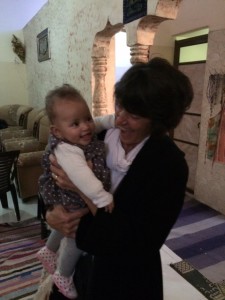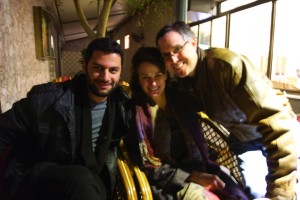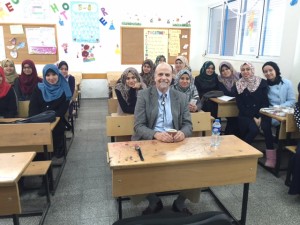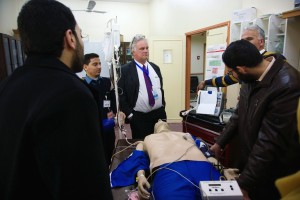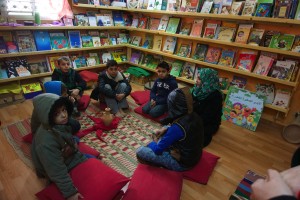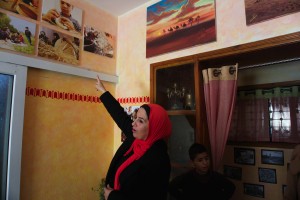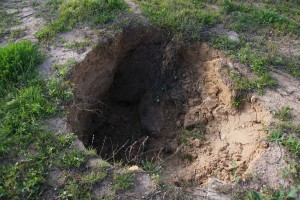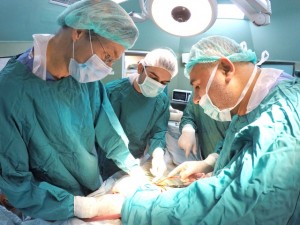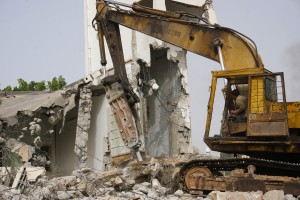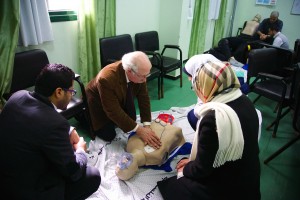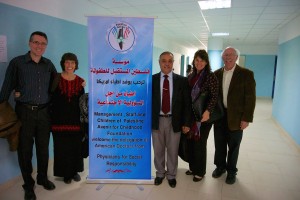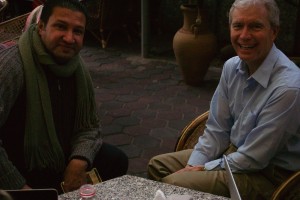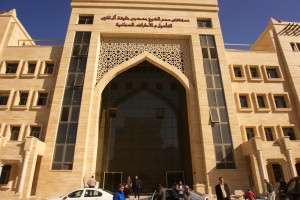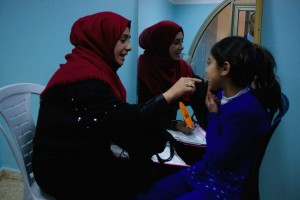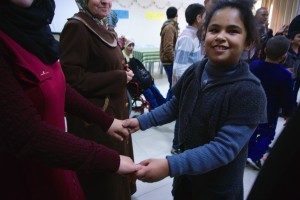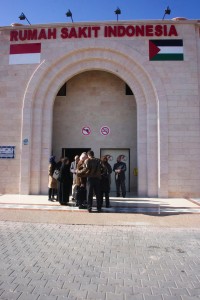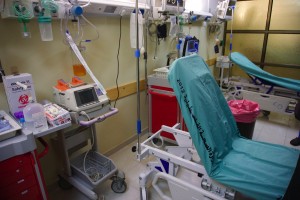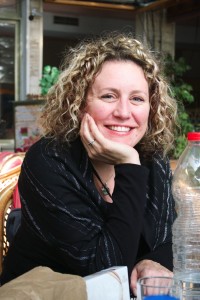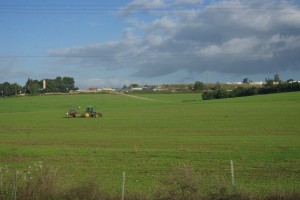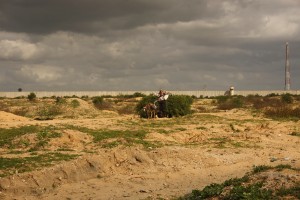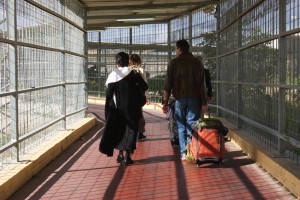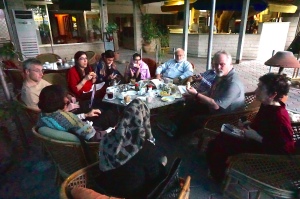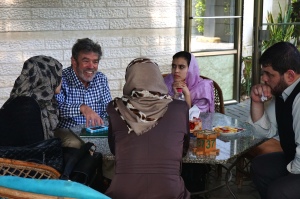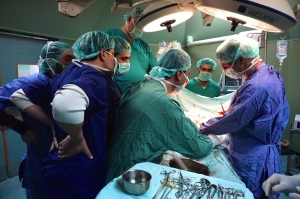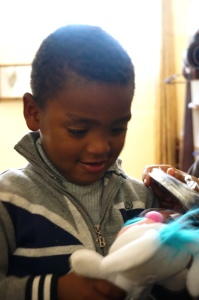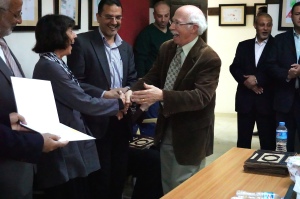With pouring rain/sleet/snow covering the land, we thought of what this means for Gaza:
* water is always needed,
* with vastly insufficient drainage systems, a rapid influx of water means flooded streets and misery,
*the cold that comes with rain/sleet/snow means more suffering for the thousands of people living in partial shelters – open walls of sheeted metal, no insulation, no electricity, no protection from water,
*over-taxed sewage and more raw sewage flowing into the Mediterranean
The list of troubles associated with winter storms is complex and life-threatening for so many people in Gaza.
As we left Jerusalem, we heard of renewed bombing – and hope this report does not mean an extended attack on Gaza. Nearly every person we spoke with in Gaza expressed anxiety over the possibility/expectation that they will come again under attack. The daily shooting of young men who venture into the “no go” agricultural zone along the Israeli border, the regular firing on boats that come too close to the imposed water border, and the constant threat of retribution for rockets fired from Gaza mean that there is no security.
That people manage to continue living in Gaza is a wonder. With unemployment at 43 – 68% (depending on age bracket), with many people who are working receiving very limited salaries (one nurse told us that he is receiving $200 – $300 every 55 days and he was grateful for this), with electricity limited to 3-6 hours every 12 hours, with the tunnel economy closed, with schools stunningly overcrowded, with medicines in short supply, with the majority of the population dependent on the underfunded United Nations Relief Works Association (UNRWA), with virtually no free-flowing potable water available, life in Gaza is exquisitely difficult. And these troubles are not the result of natural disasters – these troubles relate directly to the siege, the closure, the realties of collective punishment and living in an open-air prison.
The people and organizations we visited in Gaza are heroic – striving to provide services for one another under the most incredibly difficult circumstances. Services bringing culture and education to children, services offering care for children with special needs, services that reflect the pride and love of some of the most compassionate and courageous people imaginable.
One young man, father of three, came to visit us on our last night in Gaza. He is taking part in a “wall” project – he explained that sometimes people are shy about telling of their need for help – of their need for basic clothing. In his neighborhood, there is a wall where clothing is hung to be shared and people are invited to take what they need.
I carry this young man and his work in my heart and promise to continue to ask for the lifting of the siege of Gaza.
(Washington Physicians for Social Responsibility has traveled to Gaza since 1993. Since 2009, following the Cast Lead invasion by Israel, WPSR has sponsored ten medical delegations to serve the people of Gaza.)
In a class at the GCMHP Deir El Belah clinic this morning, we spoke of grief. The causes of grief in a land under constant threat of bombing are complex. From the grief that accompanies the physical loss of loved ones, loss through traumatic injury, loss of function, loss of hope. The list is long.
We discussed that the standard description following war – Post Traumatic Stress Disorder (PTSD) – does not apply. There is no “post” here – there is continuity of threat and stress and trauma – and the result is not generally a disorder, it is more appropriately viewed as a series of injuries: Continuous Traumatic Stress Injury. The need for mental health workers to care for themselves is critical.
No one in Gaza is immune to the stress of the ongoing siege and the possibility of further attacks and there is a constant need for the excellent work of mental health professionals. The Gaza Community Mental Health Programme works throughout Gaza – providing services in many settings.
One of our group, Janet Wright, wrote:
“Eighteen mental health clinicians at the Gaza Community Mental Health Program in Gaza City participated in a five-day training led by Janet Wright, LCSW, on treating psychological trauma in children. The training included three days of treatment for children who have experienced trauma, grief and loss as a result of war and political violence.”Dr. Chuck Cowan has continued work on autism during this visit – work that has brought him to Gaza several times.
Today, Dr. John Soos completed five days of dialectical behavior therapy training at Gaza Community Mental Health. John’s joyful approach to work here has inspired our group!
Tomorrow, we will have a tour of parts of Gaza most affected by the 2014 attacks.
(Washington Physicians for Social Responsibility has traveled to Gaza since 1993. Since 2009, following the Cast Lead invasion by Israel, WPSR has sponsored ten medical delegations to serve the people of Gaza.)
The ability to concentrate on caring for one another seems one of the strongest factors in sustaining life here. A friend told me today, “I don’t want to hear any more about resilience. We need some ray of hope to hold onto.”
Students who need to complete their graduate studies abroad are prevented from exiting Gaza to travel. The Rafah crossing remains closed – permission to travel through Erez is difficult or sometimes impossible to obtain. The prison.In a Women’s Empowerment Clinic, the reality of many more women needing care for abandonment after divorce, domestic abuse, hunger, illness – seems overwhelming. When the caregivers are also traumatized, the provision of safe care is hard. Still, the strong commitment to family and the need to make sure family members have food and are safe compels those working even minimal pay jobs to continue.
Most non-governmental agencies are cutting hours or staff or pay – trying to stretch their minimal operations budgets as far as possible. Every management person who speaks to us tells of innovative programs being designed to help the people of Gaza. Finding operations dollars to run these programs is a critical problem.This afternoon, several of our group paid a visit to the home of a friend in what is known as the ‘slave area’ – the area where descendants of African natives live. We learned of further difficulties involving poverty and violence.
One very bright part of the day – an introduction to five-month-old Gurri (Gerri) – my first namesake!
Each evening, our team gathers to review the experiences of the day. They offer many positive words about the courage of the people here. We have a good team of workers – it’s an honor to work with this group!
(Washington Physicians for Social Responsibility has traveled to Gaza since 1993. Since 2009, following the Cast Lead invasion by Israel, WPSR has sponsored ten medical delegations to serve the people of Gaza.)
There are heroes working here in incredibly difficult conditions to make life safer and more fulfilling for Gazans – despite the critical challenges of life under siege.
Issa Nahal directs a women’s empowerment center – aiding women in Rafah to gain work skills and to cope with life in this economically depressed area. SOS Children’s Village provides family-style homes for orphaned and homeless children. This inspiring facility is one of 518 villages across the world – established to aid the children of war.Also in Rafah, Wefaq organization assists women and children affected by war. We visited a computer skills training program – one designed to help prepare women for work in technology. When we asked what the women would like us to tell the people of America, their response was similar to that of almost every Gazan: “Remove the siege and let us be free.” There is a deeply resilient spirit in this land – a spirit that wants to fully participate in the world.
In central Gaza, Reem Abu Jaber, a most remarkable woman, has established a cultural center for children. In the midst of constant war threat, Reem opts to help strengthen the spirit of children by engaging them in the most loving and beautiful parts of their culture. She refuses to concentrate on war – she insists on concentrating on what will help children maintain hope and health.At NAWA Cultural Center, art, music, and storytelling are combined with the pride of service projects in the community. The children and staff also joyfully maintain the immaculately clean Center. Over the last three years, enrollment in NAWA has grown to include hundreds of local children – children who are imbued with the beauty of Gaza’s history and with the joy of being a Palestinian.
Reem’s next project is to be completed this year – the refurbishing of a 1700-year old monastery into a children’s library. She says there is always another project on the horizon to help the children of her homeland.This afternoon, journalist Mohammed Omer took some members of our group to the tunnel area of Rafah on the border with Egypt. For years, hundreds of tunnels provided access to goods for the people of Gaza. Food, fuel, cars, camels, medicines, etc. came through the tunnels and were an important part of the economy. Over the last two
years, Egypt has destroyed most of the tunnels and recently, Egypt has flooded the remaining tunnels with salt water, adding to the salinization of the aquifer and creating cracks that are leading to the development of sink holes along the populated southern edge of Rafah. Military action along this southern border is now common and threatening to the residents of this area.So we learn about life under siege and we do the work we came to do: teaching, consulting, operating. Grant O’Keefe, trauma surgeon, is occupied throughout the day at Shifa Hospital. This evening, he spoke at a surgical conference – a talk I missed but hope to hear at a later time – perhaps on the bus back to Jerusalem!
(Washington Physicians for Social Responsibility has traveled to Gaza since 1993. Since 2009, following the Cast Lead invasion by Israel, WPSR has sponsored ten medical delegations to serve the people of Gaza.)
Twelve participants in one hospital and 18 participants in one of the universities will have ACLS credentials by the end of this week!
We were again impressed by the amount of construction here – demolition and building in every neighborhood. During a visit to Al Amal Orphanage today, we learned that a newly funded structure will be built soon.
Presently, the orphanage serves 170 boys and girls, ages 5 years and above, but the last war on Gaza left many infants and very young children without families and the new structure will house children from one week to five years of age.
Orphanage administrative personnel are presently seeking funding for operations of this new facility. The orphanage is also planning installation of solar panels. With severe electrical cuts throughout Gaza (electricity often available only three to six hours per day), the advent of solar energy is eagerly anticipated.Classes in stress management offered by members of our group continue in several sites. Staff members of the Gaza Community Mental Health Programme are educating health care providers (doctors, nurses, social workers) throughout the Strip to offer mental health services to the Gaza population that is traumatically stressed by repetitive war.
The mental health providers from our group hope to offer support to this effort. No area of the 25-mile-long Gaza Strip has been untouched by the traumas of siege and war. The challenges to mental health care workers are great and the staff of GCMHP has consistently sought programs to help spread available mental health services to the community.
They are heroic and inspiring.
Music and dance are an integral part of Gaza. In a visit today to Meera kindergarten we were treated to the dancing instruction of a now-famous Gazan, known as Sweet Baby – a young man who compels every person in his presence to dance.
This kindergarten is expanding in size and service and is mainstreaming several autistic students. Again and again, the spirit of Gaza is brilliant!
(Washington Physicians for Social Responsibility has traveled to Gaza since 1993. Since 2009, following the Cast Lead invasion by Israel, WPSR has sponsored ten medical delegations to serve the people of Gaza.)
- Dr. Rich Grady, Gerri Haynes, Ahmed Al Kashif, Director, Dr. Laura Hart and Dr. Bob Haynes
- Marwan Diab and Dr. Clyde Farris planning the day (Photo by Bob Haynes)
- Qatar-funded rehabilitation hospital still under construction (Photo by Bob Haynes)
- Speech therapy in the Cerebral Palsy Center (Photo by Bob Haynes)
This morning, several of us visited the Qatar-funded rehabilitation hospital being constructed near the Mediterranean Sea. The top floor of this hospital will serve hearing-impaired individuals, including those with cochlear implants. The lower floors will serve people with amputations and orthopedic rehabilitation needs.
We had visited the existing Cochlear Implant Center in previous visits and learned that the new hospital will provide improved testing and training facilities. Funding ongoing operations has been and remains a challenge for this center and attempts are being made to find partners who will help with the costs of services and staffing. With the economy of Gaza in critical need, the present reality of work without pay in many sectors continues.
Today, also, we were treated to the first day (after vacation) of school celebration at the Palestine Avenir Association for Children. Children with cerebral palsy are served here in a most loving environment!
Center Director Ahmed Al Kashif led us through the building, greeted at every turn by staff and children, who were obviously delighted by his presence. Testing, needed therapies and academic instruction are offered at this Center.
In the play yard, merry-go-rounds and swings accommodate children in wheel chairs. A new roof structure, complete with solar panels (funded by the Czech Republic) will soon offer full electrical energy for the building. At the end of our tour, we joined the children for their musical celebration – dancing with children who have all levels of difficult movement related to cerebral palsy – including children in wheel chairs – each one smiling and offering to help us enjoy the dance!The stories we are hearing in our work and in nearly every encounter with Gaza residents reflect the extreme difficulties of life under siege and under the ongoing threat of another attack: unemployment, hunger, very limited electricity, highly polluted water, increasing domestic disputes, depression, school problems.
Life is deeply challenging in this imprisoned land. Yet again and again, we are amazed and inspired by the creativity, dedication to helping one another and amazing coping skills of the people here.
We invite the world to consider Gaza and the realities of life here.
(Washington Physicians for Social Responsibility has traveled to Gaza since 1993. Since 2009, following the Cast Lead invasion by Israel, WPSR has sponsored ten medical delegations to serve the people of Gaza.)
Today, some members of our group were treated to a tour of the newly opened Indonesian Hospital – a beautiful facility funded by donations from Indonesia’s poor. Indonesian volunteers worked for more than four years (without salaries) along side workers from Gaza to complete this 100-bed hospital, now open for about one month.
During construction, portions of building were bombed, but that damage was repaired and patients, families and staff are enjoying this gift from the people of Indonesia!
Surgeries, consultations and teaching activities in other parts of Gaza began today also.
Maria Filippone, D.O. from Iowa wrote this report:
I spent today in Basmat Amal, a resource center for cancer patients and their families in Gaza City.
I spoke with about 20 women, all survivors of breast cancer. Initially I answered their medical questions. It didn’t take long to get to the real issue. The siege. The occupation. No economy. No opportunity.Most people live on subsidies from UNRWA, which often isn’t enough to cover basic living expenses, because there is no work. There is no work because of the blockade imposed by Israel.
The blockade is so harsh that some items not allowed in at one time or another include, but are not limited to, crayons, blankets, nutmeg, dry food items, stationery, and coriander. There is no economy, no work, buildings that haven’t
been reconstructed since Israel’s latest assault, few hours of electricity per day, a sea of unknown depth full of unmet needs, and an infectious, persistent resilience and warmth in spite of everything.One woman’s question in particular shook me. She asked: “In the US you have rights for humans, even animals have rights in the US. Why can’t we have those rights? We are human.”
They need to get permits from Israel to leave Gaza for chemotherapy and radiation. These permits are often not given, or if they are, they expire before the receiving hospital in the West Bank or Jerusalem can get the medicine.
Tamoxifen is allowed into Gaza but Herceptin is not. And if the medicine is available in Gaza, it is often too expensive. Can anyone in the US imagine a reality such as this one?
At one point the look on my face betrayed my feelings of sadness, and the women immediately started comforting me, hugging me, apologizing to me for making me sad, crying with me.
(Washington Physicians for Social Responsibility has traveled to Gaza since 1993. Since 2009, following the Cast Lead invasion by Israel, WPSR has sponsored ten medical delegations to serve the people of Gaza.)
In Bethlehem, we met and were inspired by the dedication to learning and service of a visiting group of students from Manchester University (United States) – young people witnessing the situation on the ground in this part of the world. We spoke with them about our experiences in Gaza and our hopes for this visit.
The thirteen members of our group traveled by bus down from Jerusalem to the coastal plain of Israel/Palestine – passing remnants of old war, new wooded areas and productive areas of farming.The crossing from Israel to Gaza took less time (about two hours instead of four) than previous trips, but the stark contrast between the sides of the border remains. From lush green to brown, from high productivity to barren areas, the reality of the effects of continued conflict remains.
As we walked the long caged corridor into Gaza, multiple bursts of gunfire were audible in the “no go” zone adjacent to the Crossing. Approximately one-third of Gaza’s arable land is in this zone – also known also as the “security zone”. Entrance by Gaza’s farmers (and all Gazans) to this potentially productive area is forbidden and incursions are often greeted by gunfire from Israel.
We learned that more than 50% of the tens of thousands of homes partially destroyed in the 2014 war on Gaza have been repaired. Of the 1800 homes completely destroyed in that time, only five have been rebuilt. Tens of thousands of Gazans remain without homes and continue to live with extended family members, in rubble dwellings or in UN schools.Winter is particularly hard here. Electricity is available erratically and the cold that enters through fragmented walls is chilling.
After an orientation meeting with program planners from Gaza Community Mental Health Programme (the critically important organization that hosts our delegations) and an informative and gracious greeting from the medical director of the Programme, we greeted old friends, explored a bit of Gaza and prepared for the work that begins tomorrow.
Some members of our group are new to Gaza – we welcome them and are thankful for the work they will do here. For those who have returned again and again, we are grateful to be back and look forward to the days ahead.
(Washington Physicians for Social Responsibility has traveled to Gaza since 1993. Since 2009, following the Cast Lead invasion by Israel, WPSR has sponsored ten medical delegations to serve the people of Gaza.)
Slowly we complete our work here in Gaza – realizing there is no completion. How we wish for open borders and justice for the people here.
We will pass through the checkpoint tomorrow – all of our luggage will be thoroughly searched and we will be questioned about our time here, but we will emerge through the freedom of our blue passports to return to the US.
Tonight, we celebrated with Gaza Community
Mental Health staff and many people from the professional community of Gaza. We thanked them for welcoming us to their home and looked forward with them to meeting another time.We had spent the day working and visiting friends. Over and over, the grace and kindness of Gaza’s imprisoned people amazes us. It is stunning that the more than 1.8 million citizens here can cope with the reality that their borders are closed, their industry is denied, their water is undrinkable and that there is little evidence of hope for change in the near future.
Young adults all over Gaza form structured play
groups for children – groups whose goal is to teach resilience. No one pays for these groups – they are simply the work of unbroken and brilliant spirits. The young adults of Gaza inspire us.The world must know of the grave injustice being carried out against the people of Gaza. Basic human rights are denied here every day by the collective punishment of the siege and we know that the work of small groups such as ours will be unnecessary when the siege ends and human rights are restored to Gaza. For now, though, we are grateful to have participated even briefly in the lives of these courageous people.
The friends we part from are brave – they have
much to teach the world about love.